Getting your teeth straightened needn’t be a drag. Coloured braces let you show off your fun or fashionable side while your smile is improving. The only problem you’re left with is deciding which braces colours to choose!
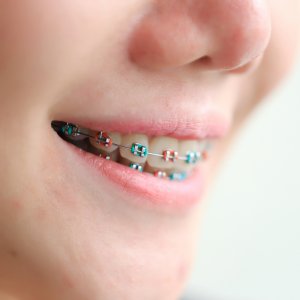
Fortunately, you’re not stuck with one colour of on your dental braces for your entire orthodontic treatment so you can experiment with plenty of different combinations. In this article, we’ll give you some ideas for choosing the best braces colours for you. We’ll also explain why you need those little bands on your braces in the first place.
How coloured braces work
Although they are often called ‘coloured braces’, this type of brace is actually made from metal. It’s the small elastic bands fitted to the brackets which allow you to add some colour.
Your orthodontist fixes a metal bracket to each tooth with a strong dental cement, then connects the brackets with a wire called an ‘archwire’. Small bands hold the wire in place. The orthodontist tightens the wire in different places to gradually pull your teeth into alignment.
It will take one or two hours to fit your braces, but each checkup will only be around 20 minutes. The actual fitting shouldn’t hurt but your teeth may feel uncomfortable for a few days afterwards and after each subsequent adjustment.
Treatment with coloured braces usually takes 18-24 months, depending on how misaligned your teeth are.
While some prefer coloured braces that stand out or blend in, others might ask if there are tooth coloured braces or even invisible braces.
Nowadays, more and more people choose a treatment with invisible aligners instead of metal braces, for a variety of reasons. If you want to find out if you can get aligners instead of fixed braces, we recommend you to book a FREE e-consultation with SmileWhite.
With these aligners, you can treat most misalignments, like you would do with metal braces.
Use our discount code “DENTALY5OFF” to save an additional 5% on your treatment.
Private vs. NHS braces in the UK
If you or your child are eligible for braces on the NHS, you’ll be given fixed braces made from metal. Should you wish to have braces that are less obvious there are several options to choose from. However, any other type of brace will only be available privately.
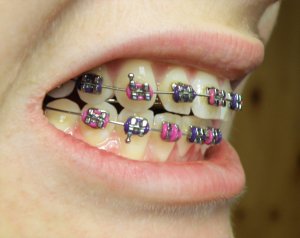
You might consider removable invisible braces or hidden lingual braces if you want to have straighter teeth without brackets fixed to the front of your teeth. There is also the option of clear braces or ceramic braces which work in the same way as traditional braces but are much less obvious.
Even if you or your child are not deemed eligible for NHS braces, you’ll probably find fixed metal braces are still the cheapest option with a private dentist. You might have access to more exciting colour options as a private patient, too.
There is one type of metal brace which doesn’t use coloured bands. Self-ligating braces (like Damon braces) have a different style of bracket which lets the wire move automatically, so no elastics are needed to keep the wire in place. Self-ligating braces are only available with private dental treatment.
Why do braces have coloured bands?
There are two main kinds of orthodontic elastics used in braces, each serving its own purpose.
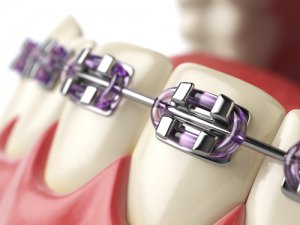
Tiny elastic bands are placed on each of the metal brackets to hold the archwire in place. These are also known as ‘ligatures’ or ‘o-rings’. The wire plays a big part in controlling how your teeth move, so those elastics have an important job to do. Ligatures are usually available in a wide range of colours with an NHS dentist.
Dentists use a special tool to fit and remove these fiddly little bands, as you’ll see in the video below.
Larger rubber bands may also be placed between the upper and lower jaw to help with alignment. This is more often the case with children’s braces. They are connected to special hooks on the brace brackets.
These are known as ‘inter-arch elastics’ and look more like the rubber bands you would use at home. They are less commonly offered in different colours, but they are usually placed on the sides of the mouth so are less visible. If your braces need inter-arch elastics you will need to learn to fit these yourself as they have to be replaced several times a day.
Here is a short video showing how a dentist puts coloured ligatures on braces to keep the archwire in place:
Colour choices
Dentists understand that having different colour braces for teeth can make patients feel more confident with their smiles. You can often view the available colours on a braces colour wheel at your clinic. Some possible options include:
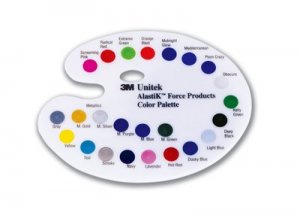
- White and clear (for a more subtle look)
- Grey and silver (to match the metal brackets)
- Bright neon colours
- Darker metallic shades
- Glow-in-the-dark elastics
However, keep in mind that different brands of braces will come with different colour options. You’ll need to ask your dentist about the exact range of colours you can choose from. Ask to view their braces colour wheel at your first appointment so you’ll have time to pick colours you’re happy with. The last thing you want is to rush your decision and later regret your choice.
Can you chose your braces colours with an NHS dentist?
Yes, all dentists offering metal braces should carry a range of elastic colours for you to choose from. Choices with an NHS dentist may be more limited than for private patients. For example, some of the more premium colours like metallic and glow-in-the dark may only be offered to private patients. Read more about braces on the NHS in our separate article.
How often can I change the colour of my braces?
You’ll be able to change your braces colours every time you visit your orthodontist for an adjustment. This is usually every 6-8 weeks during your braces treatment. You could get 12-20 different colour combinations in total, so you’d better get thinking!
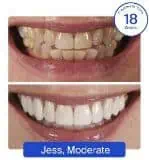
- Treats up to 90% of Cases
- Up to 40% cheaper than Invisalign
- Buy now, pay later in interest-free instalments
- Rated 4.9/5 on Trustpilot
- As seen on 5, BBC, 4, DailyExpress, TheMail
- Get 5% OFF with our discount code DENTALY5OFF and FREE Whitening and Retainers worth £790
How to choose the best colours for your braces
There are many different ways that people choose the best braces colours for them. Some people prefer to start off with something low-key and gradually get more adventurous. If you’re struggling to narrow down your choice to just one or two colours then what about rainbow braces?
Also consider whether you want your braces to stand out or blend in. It can be fun to show off bright colours at school, but neon elastics might look out of place in an office job.
Here are some good braces colour ideas to consider:
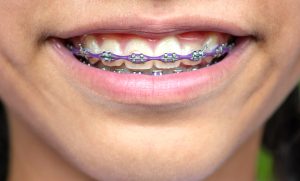
- Complement your eye colour
- Match the clothing colours you like to wear
- Choose bright colours in summer and cool blues in winter
- Red and green for Christmas
- Black and orange for Halloween (but remember they’ll be on for up to two months!)
- Your favourite sports team’s colours
- Your school colours
- Red, white and blue braces to show your patriotism
- Silver or grey if you don’t want them to stand out
- Darker shades to make your teeth look whiter
You could also take a more scientific approach to finding the best colour of braces for you. Different colours and shades look good against different skin tones, so you could pick some good braces colours that way instead.
What braces colours look good together?
If you’re going for a colour combination on your braces, you could pick two shades of the same colour for a more subtle look, or a contrasting pair to stand out more. Pink and purple work well together, or you could take some inspiration from the list above.
The great thing is that since your elastics change so often, you’ll have the chance to try plenty of combinations. If you decide you don’t like your current one, you’ll only have to live with it for a few weeks before being able to update your style.
Which colours are not good for braces?
If you’re a fan of colourful foods like curries and tomato sauces you might want to avoid white and clear bands on your braces. This is because they are more easily stained (just like a white shirt). Wine, coffee and tea are also staining culprits. If you want a colour that’s discreet but won’t show stains as easily, try grey or silver to blend in with the metal brackets.
Another downside of white braces is they can make your teeth look yellower in comparison.
Some people choose to avoid yellow braces – especially light yellow – as from a distance they may look like stains. Similarly, green braces might be mistaken for a bit of spinach left over from lunch!
Black isn’t a popular colour (except perhaps for teens wanting to make a statement). But if you want braces colours that make teeth look whiter, you might go for dark purple or dark blue. These darker colours provide contrast to make your teeth appear lighter.
Here is a summary of the effects that various colours of brace can have:
Braces colour | Effect |
White or clear | Less noticeable but picks up stains and can make teeth seem discoloured |
Dark colours | Make teeth appear whiter |
Yellow and gold | Could look like stains and highlight yellowness of teeth |
Dark blue, gold, turquoise, violet, red, green, orange and pink (bright colours) | Suit darker skin tones and hair colours |
Light blue, dark purple, bronze, teal, plum, soft reds and pinks | Suit lighter skin tones and hair colours |
Colour braces for children and teens
As a parent, you may be dismayed at your child’s choice of colour for their braces, but keep in mind that this is just another way for them to express their personality. It’s really no different to them choosing which colour clothes to wear each day.
Your child or teen may not be too happy about having to wear braces in the first place, but you can make the experience more enjoyable by letting them have full control over the band colours they choose.
A braces colour picker can help you visualise how a particular combination will look once fitted.
You’ll also have to help your child take care of their braces. This will include:
- Cleaning and flossing carefully every day
- Avoiding certain foods as directed by your dentist
- Wearing a mouth guard for any contact sports
- Attending regular checkups
- Wearing a retainer after braces are removed
Oral hygiene is particularly important while wearing braces. If they are not cleaned properly they become a breeding ground for bacteria which can lead to tooth decay and other oral health problems for your child.
If you don’t already have an electric toothbrush for your child, consider investing in one with a special head for orthodontic cleaning. A water flosser may also come in handy – these machines emit high-pressured jets of water to clean between teeth and dislodge food stuck in braces. You and your child will probably find this much easier than trying to clean around braces with fiddly dental floss.
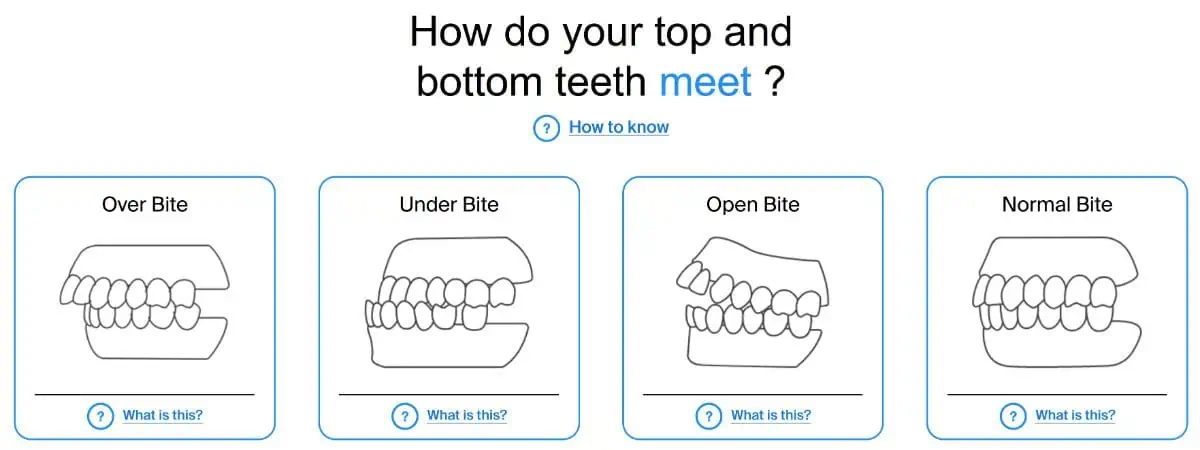
Popular braces colours
It’s up to you whether you choose a completely original colour combination or select colours for your braces based on what’s popular. Here is some final inspiration from us based on the most common colours for braces.
Pink braces
It’s a fact that many girls love wearing pink, but this colour can look good on boys, too. You can’t go wrong with a cute purple and pink braces combination.
Women often choose colours for braces that match their favourite shade of lipstick or their natural lip colour. There’s nothing like a fully co-ordinated look!
Blue braces
Dentists usually offer several shades of blue braces. Pairing a lighter and darker shade is a pretty safe bet for any patient. Blue is also a good colour for braces because it’s unlikely to clash with any of your clothes. Plus, if you have blue eyes it will help bring out the colour in them.
Rainbow braces
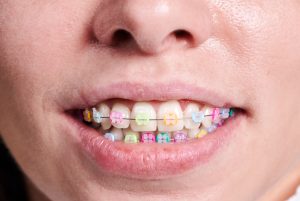
Can’t choose just one or two colours? Then go for a whole rainbow across your teeth! Do note that some dentists restrict patients to just two different colours of braces at each visit, so you’ll have to check whether you’ll be allowed to get rainbow braces at your local practice.
Grey or silver
Grey and silver are a popular braces colour choice for adults who don’t want to make their braces stand out any more than they have to. They blend in with the braces themselves and can look a bit more professional than a rainbow of bright colours. Few workplaces are likely to object to you having coloured braces, but it might be worth checking if your job is particularly formal.
White or clear
If you get ceramic braces like Clarity Advanced or Radiance Plus, which are less noticeable than metal, it makes sense to choose subtle colours for your elastics too. These are usually white or clear, depending on the type of brackets you have. Be careful with what you eat and drink because these are the most likely to stain.
In summary
Coloured braces are a fun way to express your personality while getting your teeth straightened. Choosing a colour can be harder than you think, but you’ll have plenty of chances to switch during the course of your treatment.
Dentists usually offer a choice of coloured elastics as standard with fixed braces but it’s worth checking this ahead of time to avoid disappointment.
If you’d rather go for a less obvious look then invisible braces or ceramic braces could be a better choice.
Paint Your Smile http://paintyoursmile.com/index.php Consulted 24th April 2019.
British Orthodontics Society https://www.bos.org.uk/Public-Patients/Orthodontics-for-Children-Teens/Fact-File-FAQ/FAQ-for-Children-Teens/Can-I-have-colours-on-the-brace Consulted 24th April 2019.




